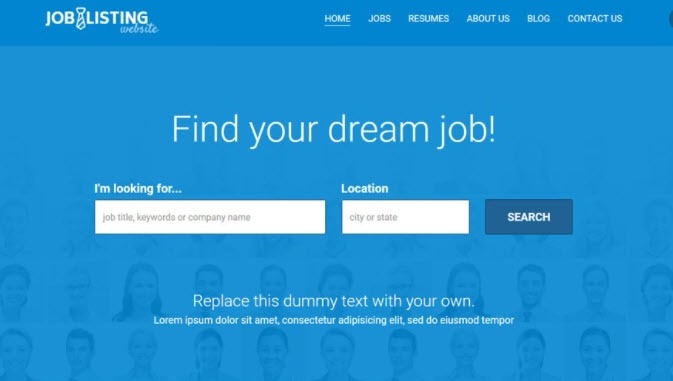
If you want to set up a career website or you want to make your career website easier to find, you will find many blogs that all say the same thing.
But unfortunately, many of these blogs do not provide any of the tips below. And that is unfortunate for them, but very nice for you :-).
1. Think carefully about the domain (subdomain, separate website, main website)
If you want to set up a careers part, the first important choice is which domain you want to put the vacancies in.
And I consciously say 'part' and not 'website' because you can also place the careers on a subdomain, on your own website or within your regular website. Suppose we would like to set up a work-bee, these are the three possibilities:
- yourjobwebsite.com/job-one (A subfolder)
- yourjobwebsite2.com (A separate website)
- job-one.yourjobwebsite.com (A subdomain)
Which option is best for you depends on many factors. This depends on so many factors that I could devote a separate blog to this.

To help you on your way, I will already share the most important arguments for you:
- Option 3 is always dropped. A subdomain is not a good choice (for SEO).
- A separate website is super cool because you then have a separate website for one target group, but you have to have a very separate website made. You have to maintain your regular website and your career website.
- Via a subfolder, you can easily set up working at section, and you can profit from the success of your regular website.
The conclusion is actually as follows: are you a smaller organization with not a lot of budget, and do you want to set up a job? Then go for a subfolder.
Are you a larger company, is recruitment an important part and do you need new people every few months? Then go for a separate website.
2. Link the websites to each other (for link building purposes)
Link building is an important part of SEO and is nothing more than obtaining quality links to increase the value of your website.
If you link the websites to each other, part of that value is passed on. And both domain names benefit from this.
Besides linking the websites to each other for Google, you also link them to each other for the visitor. You want people to be able to see who your organization is or what your career website is.
If you have a subfolder instead of a subdomain or a separate website for your career website, linking to your career section is also important. Only then does it fall under internal link building.
3. Provide cross-domain tracking
You should have installed Google Analytics on your website because you want to see how many people are on your website, what they are viewing, how they behave, etc.
Of course, you also do that for your career website because you want to have everything transparent. But suppose someone enters your regular website. That is then seen as one session.

That person then clicks on your career website and applies. This is again seen within your careers website as one session, and Google does not recognize these sessions as coming from the same person.
Cross-domain tracking solves that problem. With cross-domain tracking, you can see those two sessions as one session, and that means that your data becomes much more valuable and that you can see the results of your campaigns even better.
4. Make sure that the conversions have been made measurable
I want to go a little further on what each campaign delivers. To know what your campaigns deliver, everything must be measurable. In other words: you have to set up conversions.
When you normally speak of conversions, people often think of someone making a purchase. But even more, conversions are important. Those are:
- Filling out contact forms
- Requesting quotes
- Clicks on email address
- Clicks on phone number
These are, of course, also important within your careers website, but several conversions can also be important:
- Call-me-back form
- Application form
- Click on WhatsApp (when people can apply via WhatsApp)
- Sharing a vacancy
Make sure these are all measurable within Analytics.
5. Make sure the mobile design is flawless
This really feels like an open the door to me personally, but I still see so many websites today that are not optimized for mobile.
In tip 1, I told you that setting up a separate career website entails extra costs. Think of building, hosting and marketing.

Because a careers website costs extra money, I often see that savings are made on building the website. And that can mean two things:
- The careers website is ancient and therefore not mobile-friendly.
- The careers website is fairly new, but construction savings have been made, and so the website is not mobile-friendly.
Both are really no longer possible in 2021 today. Therefore, always make sure that the mobile website is in perfect condition.
The figures also show that more and more people visit vacancy websites via mobile… and apply for jobs.
6. Don't forget the mail-a-friend (or share function) function
In tip 4, I already mentioned that you could see sharing a vacancy as a conversion. You can, of course, only install the share function on the website.
And I call that function the mail-a-friend function. Of course, someone may see a vacancy and thinks: 'hey, that's something for Pietje. I have to send it on '.
Then, of course, you want to make that as easy as possible for Pietje's friend. This ensures that your website can be shared more easily and will therefore be visited by more people.
But for Pietje himself, the mail-a-friend function is also handy. Pietje can see the vacancy herself and think: 'what would my girlfriend think about this?'.
If the mail-a-friend function is in it, the girlfriend can respond that it is a nice vacancy. If the position is not there, then you pass those opportunities.
7. Build in a job alert function (automate email marketing)
Suppose you have an online marketing agency and the abbreviation of your online marketing agency is OMA. You are looking for an SEO specialist. Only Maud is on your website to see if there is a vacancy for a SEA specialist.
Unfortunately, there is currently none. You can build in an option on your career website that people leave their e-mail address and that you email them when a new vacancy becomes available.
This way, you can build your own database of marketers over the years. One that you can always email whenever you want.
And of course, you can automate the first few emails you send with a piece of email automation. Consider, for example, the first email with 'Thank you for leaving your email address. We will be the first to keep you informed of the latest vacancies.
8. Make sure the careers website is above the fold on your regular website
Whether you have a separate career website, a subfolder or a subdomain, it is important for all three that you prominently display the career website. Do not hide it at the bottom of the footer or in the 'about us' submenu.
Then potential candidates will never find the link.
9. Find relevant keywords for your work at the website and write landing pages or blogs for them
Tip 109 is, of course, all about SEO: making a website organically easier to find. The basis for SEO is the keywords.
These are also important when working on the website. You want to score on:
- Vacancies [company name]
- Working at [company name]
- Vacancies [job description]
- Vacancies [field] [location]
- Etc.
If you can be found on those keywords, it can yield potential candidates. And that is what everyone who sets up working at the website wants.
10. Install the Facebook and LinkedIn Pixel for similar audiences and retargeting
The Facebook and LinkedIn Pixel ensure that you learn more about who is on your website.
If you subsequently bring in relevant visitors to your website, there are two campaigns that we recommend:
- Similar target groups campaign
- Retargeting
I explain them both briefly. Suppose you have relevant visitors to your careers website, and they convert and apply. With a similar target group campaign, you can target similar people with social media.
These are people who look like the people who have been on your website. And if they have applied, that's exactly what you want.
The second campaign is the retargeting campaign. It is, of course, possible that people go on to another career website after visiting your website to see what the possibilities are there.
By setting up a retargeting campaign, you can retarget the people who have been on your website and approach them again.
For example, you can show blogs where employees explain what they do for you, how happy they are, and what you achieve/do for customers.
After all, that is what candidates want to see - and with which you pull them over.


